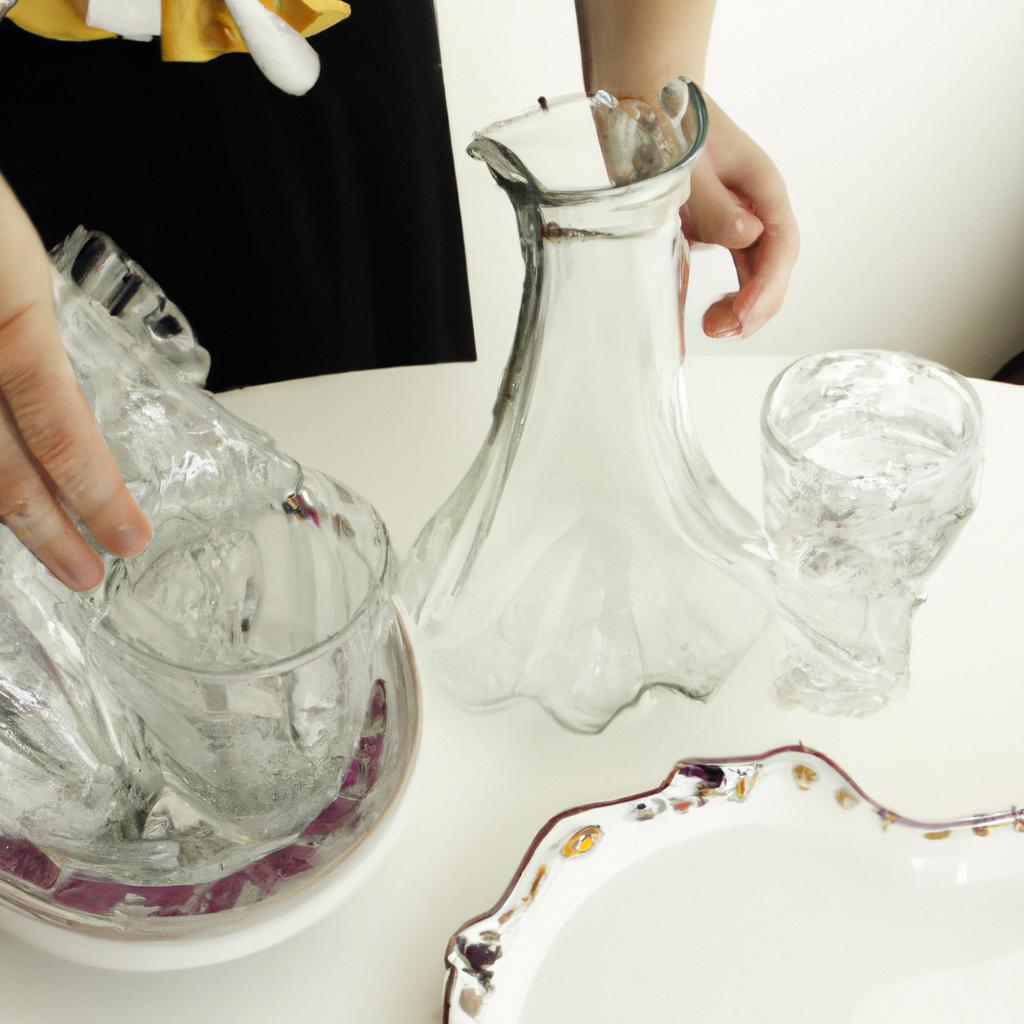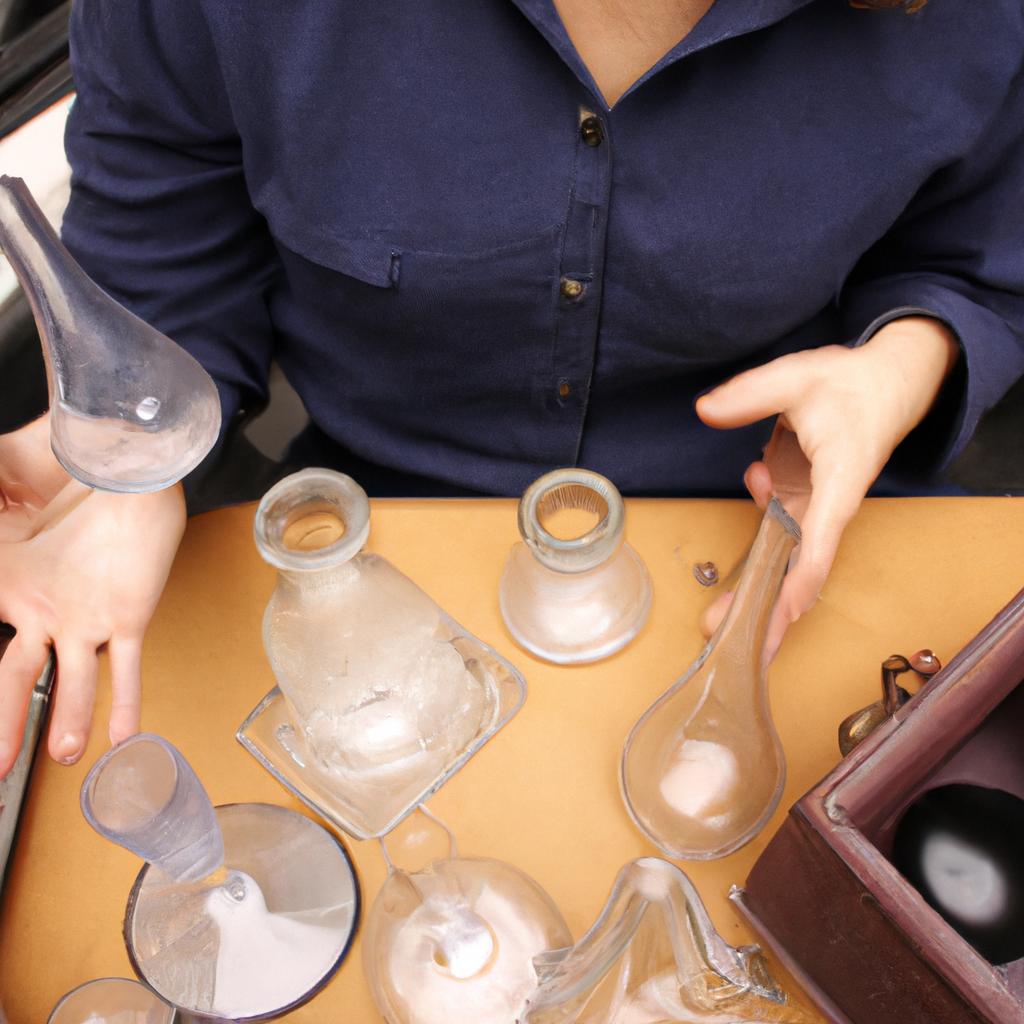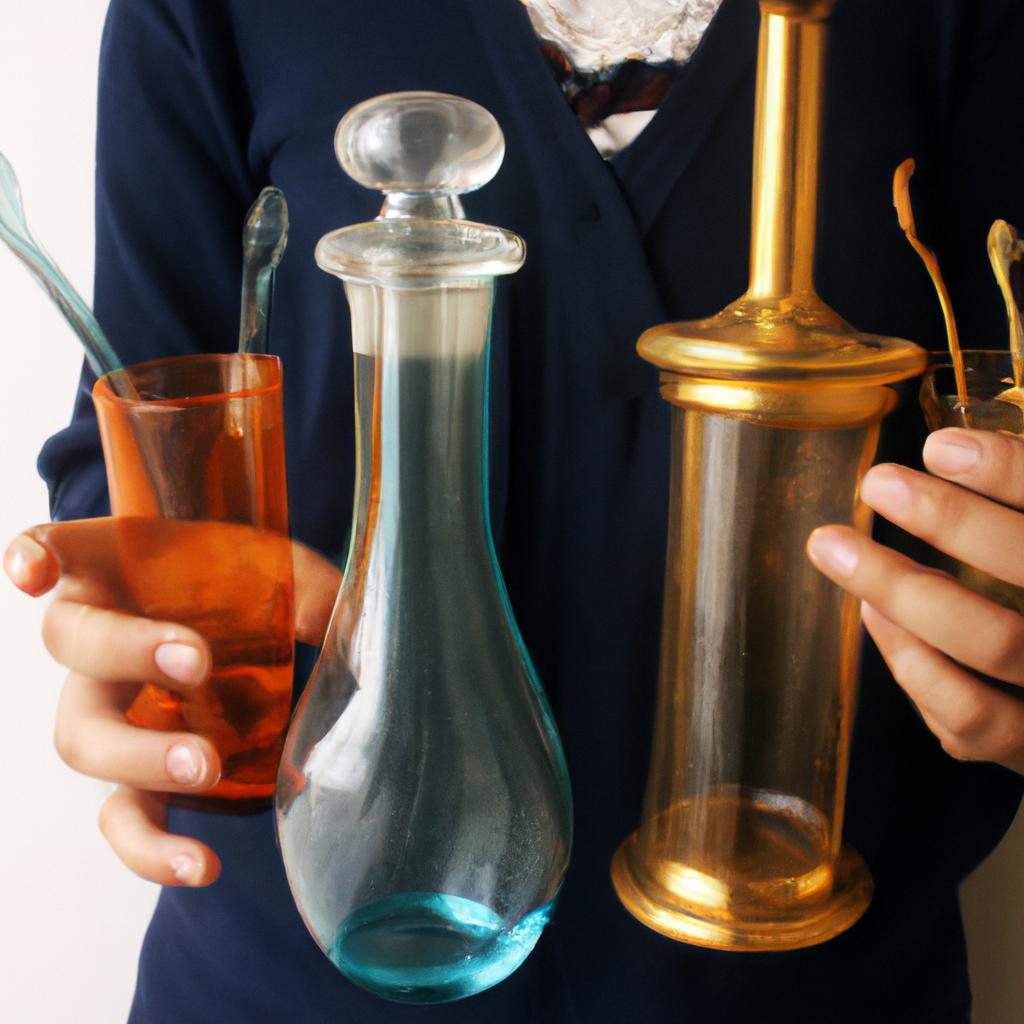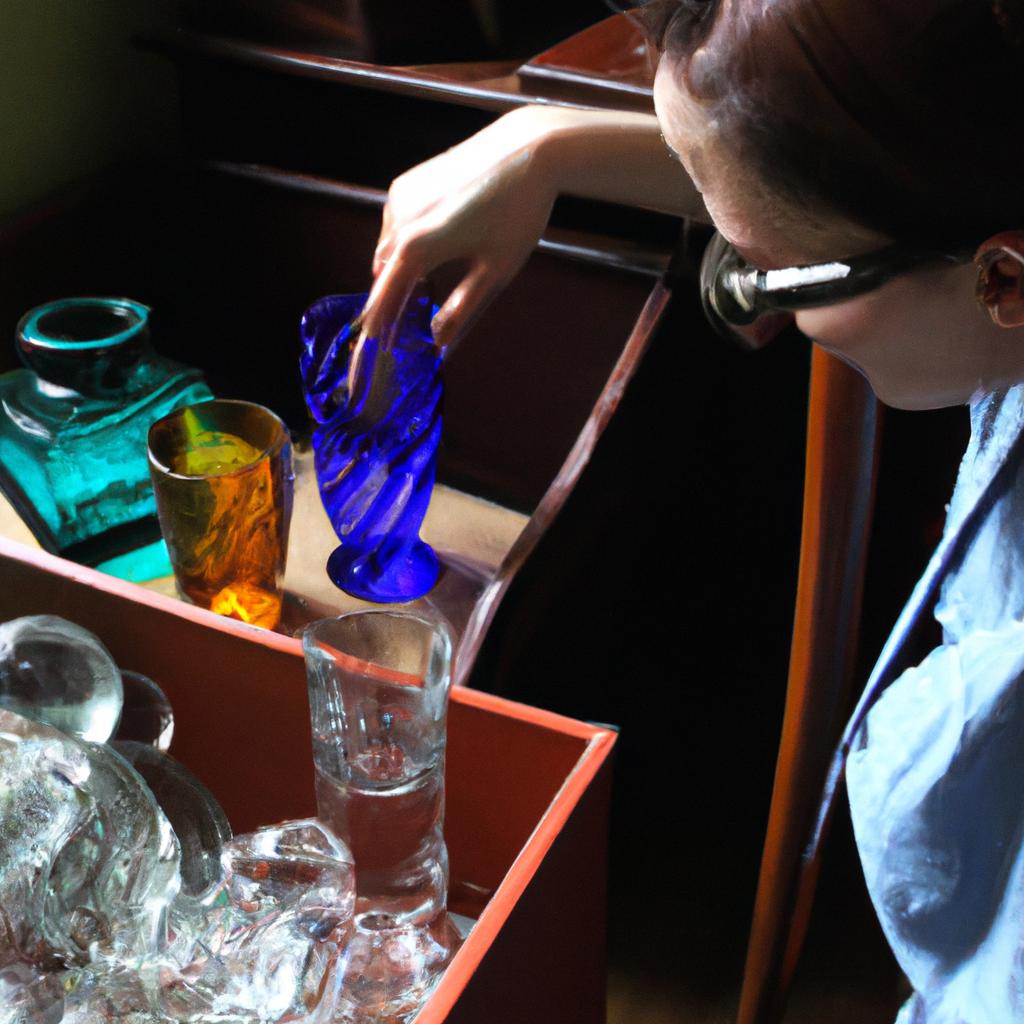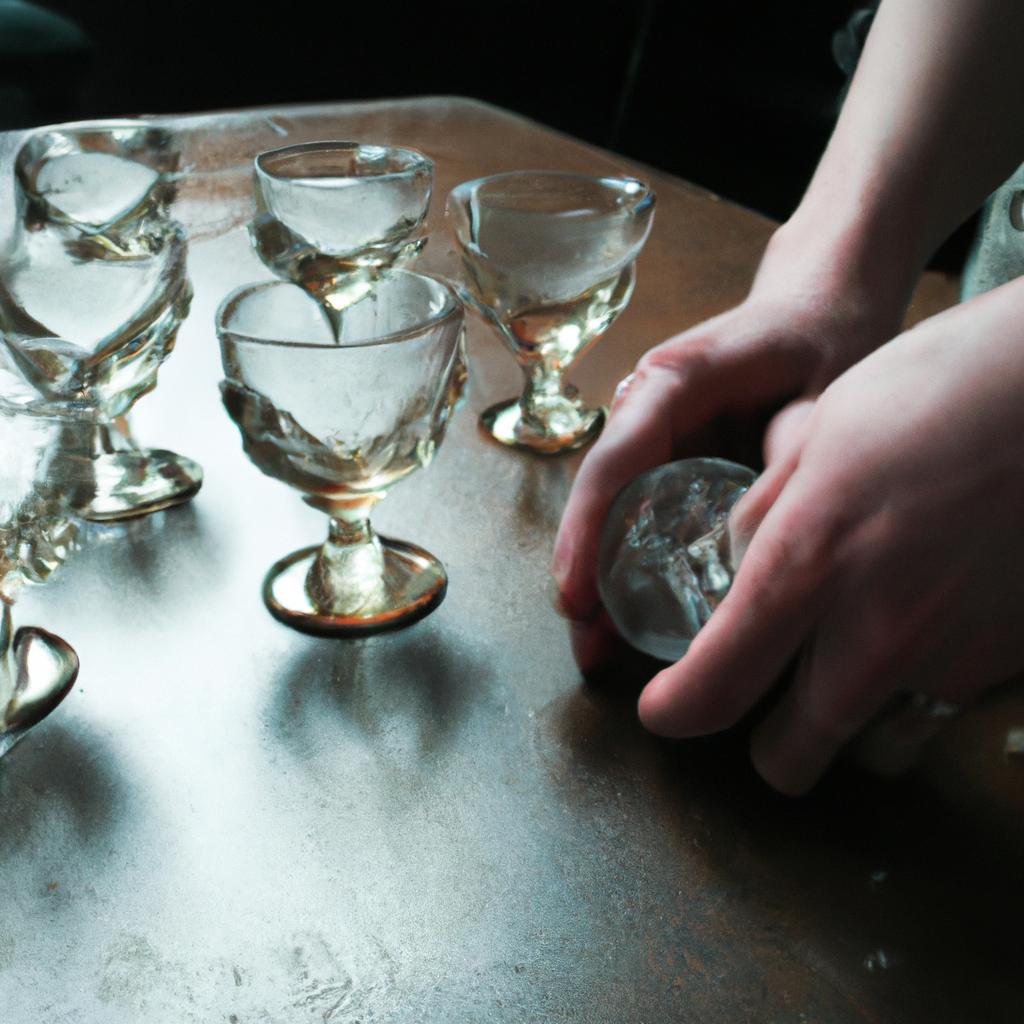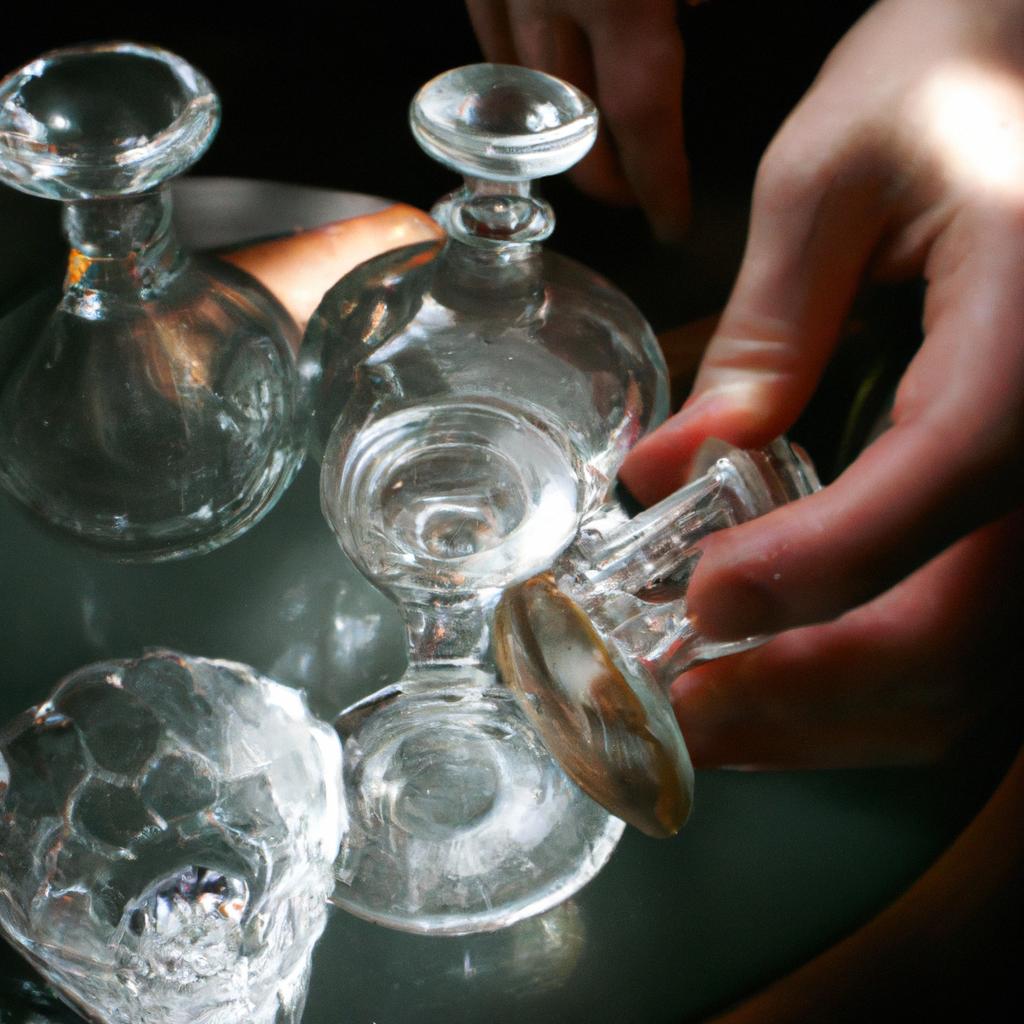Vintage Glassware: A Guide to Antiques and Collectibles

Vintage glassware holds a unique allure for collectors and enthusiasts alike, as it embodies the beauty and craftsmanship of bygone eras. From intricately designed crystal goblets to delicate pressed glass patterns, these artifacts offer glimpses into history while adding elegance to any home or collection. This article aims to serve as a comprehensive guide on vintage glassware, providing readers with an overview of its origins, types, and factors to consider when collecting.
Imagine stumbling upon an exquisite 1920s Art Deco champagne coupe at a flea market – its stem adorned with intricate geometric designs that transport you back in time. Such discoveries ignite a passion within individuals who appreciate the artistry and historical significance behind vintage glassware. Whether one seeks pieces from specific periods like the Victorian era or iconic manufacturers such as Tiffany & Co., understanding the nuances of antique glass can facilitate informed decisions during acquisition or appraisal processes.
Through this article, we will explore the rich heritage of vintage glassware. By delving into topics like production techniques, popular styles throughout different eras, and notable designers and manufacturers, readers will gain valuable insights into identifying authentic pieces and assessing their value. Additionally, practical advice regarding care and maintenance will be provided to help preserve the longevity and beauty of cherished collections. Ultimately Ultimately, this guide aims to foster an appreciation for the artistry and craftsmanship of vintage glassware while empowering collectors and enthusiasts with knowledge that will enhance their experiences in acquiring, displaying, and caring for these treasured artifacts. Whether you are a seasoned collector or just starting your journey into the world of vintage glassware, this comprehensive guide will serve as a valuable resource to help you navigate the intricacies of this fascinating hobby.
Value of old glassware
Vintage glassware holds a significant value in the world of antiques and collectibles. Understanding the factors that contribute to the worth of old glassware is essential for collectors, enthusiasts, and sellers alike. This section will explore some key elements that determine the value of vintage glassware.
To illustrate these concepts, let’s consider an example of a rare 19th-century hand-blown crystal vase from France. This exquisite piece showcases intricate etchings and delicate craftsmanship, making it highly sought after by collectors worldwide. The uniqueness and historical significance of this particular item significantly impact its value in today’s market.
Several factors influence the value of vintage glassware:
-
Rarity: The scarcity or limited availability of a specific type or design can greatly enhance its desirability among collectors. For instance, if only a few examples of a certain pattern were produced or if production ceased many years ago, the rarity factor increases exponentially.
-
Condition: The condition plays a crucial role in determining the value of vintage glassware. Pieces that retain their original luster with minimal damage or wear are generally more valuable than those with chips, cracks, or heavy signs of use.
-
Historical Significance: Glassware associated with notable events, renowned manufacturers, or influential designers often commands higher prices due to its historical importance. Collectors are drawn to pieces that have contributed to shaping art movements or cultural trends throughout history.
-
Aesthetics and Design: The visual appeal and artistic merit of vintage glassware heavily influence its market value. Unique patterns, elaborate decorations, and innovative techniques can elevate the worth of even lesser-known manufacturers’ creations.
Emotional response:
Consider these bullet points as you immerse yourself in the enchanting world of vintage glassware:
- Discovering hidden treasures at flea markets ignites a sense of excitement and anticipation.
- Holding delicately crafted antique glasses transports us back to glamorous eras gone by.
- Imagining the stories behind each piece evokes a sense of nostalgia and connection to the past.
- Preserving these delicate artifacts ensures that future generations can appreciate their beauty and historical significance.
In addition to understanding the value of vintage glassware, it is essential for collectors to identify authentic pieces accurately.
Identifying vintage glassware
Vintage Glassware: A Guide to Antiques and Collectibles
Section H2: Identifying vintage glassware
To illustrate this process, let’s consider a hypothetical scenario involving a collector who has come across an intricately designed glass vase at an estate sale.
Identifying vintage glassware can be a meticulous task that requires knowledge and attention to detail. There are several key factors to consider when determining the age and origin of a piece:
-
Style and Design:
- Different eras in glass production were characterized by distinct styles and design elements.
- For instance, Art Nouveau pieces often feature organic shapes and intricate floral motifs, while Mid-Century Modern designs tend to have clean lines and geometric patterns.
-
Markings or Signatures:
- Many manufacturers marked their pieces with stamps, etchings, or labels indicating the brand or artist.
- Researching these markings can help identify both renowned makers and lesser-known artisans who produced unique pieces.
-
Construction Techniques:
- The method used to create the piece can offer clues about its age.
- Early hand-blown glass will display imperfections such as bubbles or asymmetry, whereas mid-20th century machine-made glass tends to have more uniformity.
-
Materials Used:
- Examining the type of glass used can provide valuable insights into the origins of a piece.
- Some notable types include pressed glass, carnival glass, milk glass, cut crystal, and colored art glass.
By considering these aspects in conjunction with other research resources like books, online databases, and expert opinions, collectors can gradually uncover the hidden stories behind their cherished finds.
Moving forward into our next section on tips for cleaning and caring for old glassware, it is essential to ensure proper maintenance to preserve the beauty and value of these delicate treasures.
Tips for cleaning and caring for old glassware
Transitioning from the previous section on Identifying vintage glassware, it is important to note that once you have acquired a piece of antique or collectible glassware, proper cleaning and care are crucial in preserving its value and beauty. Let us consider an example to illustrate this point. Imagine you come across a stunning crystal vase from the 1920s at an estate sale. Its intricate design captures your attention immediately, but upon closer inspection, you notice some dirt and grime accumulated over the years. How can you clean this delicate artifact without causing any damage?
To ensure the longevity of your vintage glassware, here are some essential tips for Cleaning and Caring for these cherished pieces:
- Handle with Care: When handling old glassware, always use gentle hands and avoid applying excessive pressure. Even seemingly small force could result in chips or cracks.
- Use Mild Detergents: Avoid using harsh chemicals or abrasive cleaners when washing antique glassware. Instead, opt for mild dish soap mixed with warm water to gently remove dust and dirt.
- Soft Brushes or Cloths: Utilize soft-bristled brushes or non-abrasive cloths to clean hard-to-reach areas or delicate patterns on your vintage glassware.
- Air Drying: After cleaning, allow your glassware to air dry naturally rather than using towels which may leave lint behind.
Table: Do’s and Don’ts of Cleaning Vintage Glassware
| Do | Don’t |
|---|---|
| Clean one piece at a time | Place multiple items in close proximity during cleaning |
| Test cleaning methods on a small inconspicuous area first | Submerge fragile glass in hot water |
| Store cleaned pieces individually | Stack them haphazardly |
| Keep away from direct sunlight | Expose them to extreme temperature changes |
In conclusion, cleaning and caring for old glassware is a delicate process that requires attention to detail. By following these tips and guidelines, you can ensure the preservation of your vintage glassware’s beauty and value for years to come.
Transitioning into the subsequent section about different types of collectible glassware, it is essential to explore the vast array of options available in this fascinating world. Understanding the various categories will enable collectors to enhance their knowledge and make informed decisions when expanding their collections.
Different types of collectible glassware
With a clear understanding of how to clean and care for old glassware, let’s now delve into the different types of collectible glassware that enthusiasts can add to their prized collections.
Types of Collectible Glassware
When it comes to vintage glassware, there is an extensive range of styles and patterns from various time periods. Here are some popular types you might come across:
-
Depression Glass: Produced during the Great Depression era in the 1930s, depression glass was often given away as promotional items or sold at low prices. It comes in vibrant colors like pink, green, blue, and amber and features intricate designs such as ribbed patterns or floral motifs.
-
Mid-Century Modern Glass: This style emerged after World War II and is characterized by its sleek lines and minimalist design. Pieces from this period often feature bold geometric shapes and vibrant hues.
-
Carnival Glass: Also known as “Iridescent Ware,” carnival glass gained popularity in the early 1900s due to its affordable price and attractive appearance. It has a distinctive iridescent sheen which reflects a variety of colors when held up to light.
-
Cut Glass Crystal: Known for its exquisite craftsmanship, cut glass crystal originated in Europe during the late 18th century. These pieces are intricately decorated with deeply cut designs that create a sparkling effect when exposed to light.
- Discover the elegance of bygone eras through your own collection.
- Immerse yourself in nostalgia as you uncover unique treasures.
- Experience the thrill of hunting down rare pieces at auctions or flea markets.
- Share your passion with fellow collectors who understand your appreciation for vintage beauty.
| Type | Time Period | Characteristics |
|---|---|---|
| Depression Glass | 1930s | Vibrant colors; ribbed patterns or floral motifs |
| Mid-Century Modern | Post-WWII | Sleek lines; minimalist design |
| Carnival Glass | Early 1900s | Iridescent sheen; reflects a variety of colors |
| Cut Glass Crystal | Late 18th century | Intricate cut designs; sparkling effect when exposed to light |
Exploring these various types and their distinguishing features will help you make informed decisions as you embark on starting your own vintage glassware collection. So, let’s now delve into the exciting world of building your very own collection.
Starting a vintage glassware collection
Section H2: Recognizing Different Types of Collectible Glassware
Glassware collecting is a fascinating hobby that allows enthusiasts to explore the rich history and craftsmanship of vintage pieces. In this section, we will delve into various types of collectible glassware, each with its unique characteristics and appeal.
One example of highly sought-after collectible glassware is Depression glass. Produced during the 1920s and 1930s in response to the economic hardships of the Great Depression, these translucent colored glass pieces captured the spirit of hope amidst challenging times. The soft hues and intricate patterns found in Depression glass make it a beloved choice for collectors around the world.
When building your own collection, consider these key points:
- Rarity: Some glassware styles were only produced in limited quantities or for a short period, making them more valuable.
- Condition: Look for pieces without significant damage or wear as they tend to retain their value better.
- Design: Certain patterns or designs may be more desirable among collectors due to their aesthetic appeal or historical significance.
- Manufacturer: Glassware made by well-known companies such as Tiffany & Co., Fenton, or Lalique often commands higher prices due to their reputation for quality craftsmanship.
To further illustrate the diversity within collectible glassware, let’s examine three popular categories:
| Category | Characteristics | Examples |
|---|---|---|
| Art Deco | Geometric shapes | Lalique crystal figurines |
| Mid-century modern | Bold colors | Blenko hand-blown vases |
| Cut glass | Intricate patterns | Waterford crystal stemware |
These are just a few examples from an extensive range of possibilities when it comes to collectible glassware. Exploring different categories can help you identify which style resonates most with your personal taste and preferences.
Transitioning into our next section about recognizing markings and signatures on antique glassware, it is important to understand the distinct characteristics of each type. By familiarizing yourself with the unique features of different collectible glassware styles, you will be better equipped to appreciate their value and make informed decisions when adding pieces to your collection.
Recognizing markings and signatures on antique glassware
As you embark on your journey into the world of vintage glassware, it is essential to familiarize yourself with Recognizing markings and signatures on antique pieces. These unique identifiers can provide valuable insights into the origin, age, and authenticity of the glassware you encounter. By honing this skill, collectors can make informed decisions about their acquisitions and potentially uncover hidden gems within their collections.
Recognizing markings and signatures on antique glassware requires careful observation and research. One way to begin is by examining various forms of identification that may be present on a piece. For instance, many manufacturers would mark their wares with an etched or engraved signature, while others might use paper labels or stamps. By deciphering these marks, collectors can trace back the manufacturer’s history and gain insight into the time period during which a particular piece was produced.
In addition to identifying specific markings or signatures, there are several key factors to consider when assessing the value of vintage glassware:
- Condition: The overall condition of a piece significantly affects its worth. Chips, cracks, repairs, or excessive wear can diminish both aesthetic appeal and monetary value.
- Rarity: Uncommon designs or limited production runs often drive up prices in the collector’s market.
- Historical significance: Glassware associated with notable events or individuals from history holds greater allure for collectors.
- Quality craftsmanship: Pieces that showcase exceptional artistry, precision workmanship, or innovative techniques tend to fetch higher prices.
To illustrate how these factors interplay in determining value, consider a hypothetical scenario involving two identical 19th-century crystal goblets from different manufacturers. While both bear similar intricate engravings and exhibit excellent condition overall, one bears an additional signature indicating it once belonged to a prominent historical figure—an attribute that elevates its desirability among collectors. Consequently, despite sharing nearly identical physical qualities with its counterpart, the goblet with historical significance would command a higher price in the market.
Recognizing markings and signatures on antique glassware is an essential skill for any collector. By understanding these unique identifiers and considering various factors that contribute to a piece’s value, collectors can make informed decisions about their acquisitions. In the subsequent section, we will explore the different factors that affect the value of vintage glassware, shedding light on additional considerations for aspiring collectors.
Factors that affect the value of vintage glassware
Recognizing Markings and Signatures on antique glassware can be a fascinating endeavor for collectors and enthusiasts. These distinctive marks provide valuable insights into the origin, age, and craftsmanship of vintage glass pieces. By familiarizing oneself with these unique identifiers, one can gain a deeper appreciation for the historical significance and value of each item.
For instance, let us consider an exquisite Art Nouveau vase from the early 20th century. This delicate piece bears an etched signature “Émile Gallé” along with the iconic cameo technique that characterizes his work. Such distinct markings not only authenticate the piece but also reveal its connection to the renowned French artist’s oeuvre. Exploring similar identifying features in other vintage glassware allows collectors to establish connections between artists, styles, and time periods.
To help you further navigate this captivating realm of antique glassware, here are some key factors to consider when recognizing markings and signatures:
- Provenance: Determine if the marking indicates a specific manufacturer or designer associated with a particular region or country.
- Style and Technique: Evaluate how the mark corresponds to different artistic movements or production techniques prevalent during specific eras.
- Rarity: Research whether certain markings or signatures are more common or scarce, as rarity often impacts collectability and value.
- Condition: Assess any damage or wear on marked areas since it may affect both aesthetic appeal and authenticity.
Let us now delve into understanding how these factors influence the value of vintage glassware in our next section.
| Manufacturer | Signature | Period |
|---|---|---|
| Tiffany | L.C.T | 1892-1902 |
| Steuben | Aurene | 1900s |
| Lalique | France | Late 19th – |
| early 20th |
By examining such examples closely, collectors can develop their expertise in identifying important markers while simultaneously appreciating the beauty and historical significance of vintage glassware.
Moving forward, let us explore the various elements that contribute to determining the value of vintage glassware. Understanding these factors will aid collectors in making informed decisions when acquiring new pieces for their collections or personal enjoyment. In our next section, we will discuss how aspects such as rarity, condition, provenance, and demand influence the monetary worth attributed to antique glassware.
Now, let’s transition into discussing common mistakes to avoid when buying vintage glassware.
Common mistakes to avoid when buying vintage glassware
In the previous section, we explored various factors that can influence the value of vintage glassware. Now, let’s delve deeper into some common mistakes to avoid when buying these collectibles.
Picture this: you come across a beautiful piece of vintage glassware at an antique store. It catches your eye with its intricate design and delicate craftsmanship. Excitedly, you make the purchase without considering certain important factors. However, upon closer inspection, you realize that what seemed like a valuable find is actually not as valuable as it appeared. To prevent such disappointments, here are some key points to keep in mind:
- Condition: The condition of vintage glassware plays a crucial role in determining its value. Any cracks, chips or repairs can significantly decrease its worth.
- Rarity: Rare pieces tend to command higher prices due to their scarcity and desirability among collectors.
- Authenticity: With reproductions and fakes flooding the market, it is essential to authenticate any vintage glassware before making a purchase.
- Provenance: Knowing the history and origin of an item adds significant value and intrigue for collectors.
To illustrate these points further:
| Mistake | Impact |
|---|---|
| Purchasing damaged items | Decreases overall value |
| Buying mass-produced pieces | Lowers rarity factor |
| Falling for counterfeit replicas | Diminishes authenticity |
| Neglecting provenance research | Fails to establish historical significance |
By being mindful of these pitfalls while purchasing vintage glassware, you can ensure that you invest wisely in truly valuable pieces for your collection.
Transitioning into the subsequent section about “Researching the history of antique glassware,” understanding the background and context behind each piece becomes vital in assessing its true worth. By delving deep into the rich history of antique glassmaking techniques and styles, one gains a comprehensive perspective on different eras and regions. Let’s explore the importance of historical research in understanding and appreciating vintage glassware.
Researching the history of antique glassware
Having learned about the common mistakes to avoid when buying vintage glassware, it is now essential to delve into the importance of researching the history behind these antique pieces. To illustrate this point, let us consider a hypothetical scenario. Imagine you stumble upon an exquisite cobalt blue vase at a local flea market. Although captivated by its beauty, little do you know that this seemingly ordinary find could potentially be a rare mid-century Murano masterpiece worth thousands of dollars.
Researching the history of antique glassware is crucial for several reasons:
-
Authenticity verification: When dealing with vintage glassware, determining authenticity can be challenging due to counterfeits and reproductions flooding the market. Through research, you can gain insights into specific manufacturers’ techniques, markings, and styles associated with different eras or regions. This knowledge will enable you to differentiate genuine pieces from replicas more effectively.
-
Value assessment: Understanding the historical significance and rarity of antique glassware aids in assessing its value accurately. By examining past auction records or consulting reputable price guides, you can determine how sought-after certain types of glassware are among collectors and establish reasonable expectations regarding their worth.
-
Preservation and maintenance: Research allows you to uncover valuable information on proper care methods for different types of vintage glassware. From learning about appropriate cleaning techniques to understanding how exposure to sunlight or extreme temperatures may affect delicate pieces over time, thorough investigation empowers you to preserve your collection’s longevity.
-
Appreciation and enjoyment: Exploring the rich history behind antique glassware adds depth and meaning to your collection as each piece becomes a tangible connection to bygone eras and skilled artisans who crafted them. The knowledge gained through research enhances your ability to appreciate the artistry, craftsmanship, and innovation present in these timeless creations.
- Rediscover forgotten stories hidden within intricate glass patterns.
- Connect with the past through tactile experiences and sensory appreciation.
- Immerse yourself in the beauty of antique glassware, evoking a sense of nostalgia.
- Cultivate a greater understanding and admiration for historical craftsmanship.
Emotional table:
| Emotions | Experiences |
|---|---|
| Wonder | Discovering exquisite details upon close examination. |
| Awe | Viewing rare and valuable pieces that have stood the test of time. |
| Fascination | Uncovering the stories behind specific glassware manufacturers. |
| Delight | Finding unexpected treasures during your research journey. |
In conclusion, delving into the history of antique glassware provides invaluable insights into authenticity, value assessment, preservation, and ultimately enhances your appreciation for these exceptional collectibles. Armed with knowledge acquired through thorough research, you can confidently navigate the world of vintage glassware acquisition while avoiding common pitfalls. So now, let us explore how to display these remarkable pieces within your home.
With an understanding of researching antique glassware’s history under our belts, we can move on to discussing various ways to showcase vintage glassware in your home without compromising its charm or delicate nature.
Displaying vintage glassware in your home
Understanding the history and background of vintage glassware is essential for any collector or enthusiast. By delving into the origins and development of these antique treasures, we gain a deeper appreciation for their craftsmanship and value. In this section, we will explore how researching the history of antique glassware can provide valuable insights and enhance your collecting experience.
To illustrate the importance of historical research, let’s consider an example. Imagine you come across a stunning piece of glassware at an estate sale. Its intricate design and delicate details immediately catch your eye. Without knowing its history, it would be challenging to determine its true worth or place in the broader context of glassmaking traditions. However, armed with knowledge about different styles, techniques, and time periods, you can accurately identify this piece as a rare example from the Art Nouveau movement in the early 20th century.
When conducting research on antique glassware:
- Consult reliable reference books: Books written by experts in the field are invaluable resources that provide comprehensive information on various types and styles of vintage glassware.
- Examine museum collections: Museums often house extensive collections that showcase exemplary pieces from different eras. Visiting museums or exploring their online catalogs allows you to study authentic examples up close.
- Attend auctions and exhibitions: Auctions and exhibitions offer opportunities to see a wide range of vintage glassware firsthand while interacting with knowledgeable collectors who may share additional insights.
- Engage with online communities: Joining forums or social media groups dedicated to antique glassware enthusiasts enables you to connect with like-minded individuals who can offer advice, answer questions, and share their own experiences.
Incorporating emotional responses:
- Owning a beautifully crafted vintage glassware piece connects us to our past, evoking nostalgia for simpler times.
- Displaying these cherished items in our homes brings warmth and character to our living spaces.
- The delicacy and fragility of vintage glassware remind us of the importance of preserving our history and heritage.
- The beauty and elegance of these pieces can transport us to a different era, where craftsmanship was revered.
Furthermore, understanding the craftsmanship of vintage glassware allows collectors to appreciate the skill and artistry that went into creating each piece. Understanding the craftsmanship not only enhances our enjoyment as collectors but also enables us to discern quality and authenticity when evaluating potential acquisitions.
Understanding the craftsmanship of vintage glassware
Crafting vintage glassware is an art form that requires skill, precision, and a deep understanding of the materials used. By examining the craftsmanship behind these exquisite pieces, collectors can gain a greater appreciation for their value and beauty.
One example that showcases the intricate craftsmanship of vintage glassware is the renowned Venetian glass. Dating back to the 13th century, Venetian glassmakers have perfected their techniques over generations. Their delicate creations feature vibrant colors, elaborate shapes, and meticulous details, all achieved through a combination of blowing, molding, and engraving methods.
To understand the craftsmanship involved in creating vintage glassware, it’s essential to consider several key elements:
-
Form: The shape and structure of a piece are crucial indicators of its quality. Skilled artisans meticulously mold molten glass into various forms such as vases, bowls, or figurines. The consistency and balance of these shapes reflect the expertise of the craftsman.
-
Decoration: Vintage glassware often boasts intricate decoration techniques like cutting, etching, or enameling. These embellishments add depth and character to the piece while showcasing the artisan’s talent. For instance, acid etching involves selectively removing layers of glass using acid-resistant stencils, resulting in stunning designs with varying degrees of transparency.
-
Coloration: Glassmakers employ various methods to introduce color into their creations. Adding metallic oxides during production creates a range of hues from soft pastels to rich jewel tones. Alternatively, they may apply colored enamel or create layered effects by fusing multiple layers of differently tinted glasses together.
-
Quality Control: Attention to detail is paramount in crafting high-quality vintage glassware. Meticulous craftsmen carefully inspect each piece for imperfections such as air bubbles, uneven surfaces, or tiny cracks before it undergoes final polishing and finishing touches.
By analyzing these aspects of craftsmanship when evaluating vintage glassware collections or making purchase decisions, collectors can gain a deeper understanding of the artistry behind these objects and make informed choices.
| Craftsmanship in Vintage Glassware |
|---|
| Form |
| Meticulous molding techniques create unique shapes. |
Understanding the craftsmanship behind vintage glassware not only enhances one’s appreciation for its beauty but also serves as a valuable tool when assessing authenticity and value. In our next section on “Tips for selling vintage glassware,” we will explore how this knowledge can be utilized to identify rare pieces and negotiate fair prices with potential buyers.
Tips for selling vintage glassware
Transitioning smoothly from the previous section, where we delved into the craftsmanship behind vintage glassware, let us now explore some useful tips for selling these cherished antiques and collectibles. To help illustrate our points, imagine a collector named Sarah who wishes to sell her prized collection of vintage glassware.
Firstly, it is crucial for Sarah to thoroughly research and understand the market value of her glassware pieces. This involves studying recent sales records from reputable auction houses or online platforms specialized in vintage items. By examining similar items that have recently sold, Sarah can gain insights into current market trends and determine an appropriate pricing strategy for her own collection.
Once she has established a fair price range for her vintage glassware, Sarah should consider employing various effective marketing techniques to attract potential buyers. Utilizing high-quality photographs that highlight intricate details and unique features of each piece can significantly enhance its appeal online or in printed media advertisements. Crafting compelling descriptions that showcase the historical significance or rarity of the glassware further captivates potential buyers’ attention.
To maximize exposure, Sarah may also want to consider participating in relevant antique shows or exhibitions where collectors frequently gather. These events provide excellent opportunities for networking with other enthusiasts and professionals in the field, potentially leading to valuable connections and more prospective buyers.
In addition to these strategies, there are several other factors that can positively impact successful sales:
- Building a strong online presence through dedicated websites or social media platforms.
- Offering flexible payment options such as installment plans.
- Providing accurate condition reports alongside detailed provenance information.
- Offering professional packaging services to ensure safe delivery.
By implementing these approaches effectively, sellers like Sarah increase their chances of finding interested buyers willing to appreciate and preserve these remarkable pieces of history.
| Strategy | Description |
|---|---|
| Online Presence | Create a visually appealing website showcasing inventory; engage with customers through social media. |
| Flexible Payments | Offer installment plans or financing options to accommodate different budgets. |
| Detailed Provenance | Provide comprehensive information on the item’s history, including previous owners and origins. |
| Professional Packaging | Ensure safe delivery by offering professional packaging services for fragile items. |
In conclusion, when selling vintage glassware or any collectibles, it is essential to research market values, employ effective marketing techniques, and consider additional factors that enhance the buying experience. By following these strategies and incorporating innovative approaches tailored to their target audience, sellers like Sarah can increase their chances of finding enthusiastic buyers who appreciate the beauty and historical significance of vintage glassware.
Remember, success in selling vintage glassware lies not only in understanding its craftsmanship but also in effectively reaching out to potential buyers with persuasive marketing tactics.

